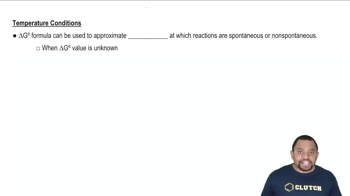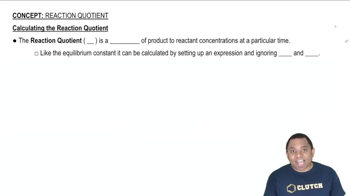Here are the essential concepts you must grasp in order to answer the question correctly.
Gibbs Free Energy (∆G)
Gibbs Free Energy (∆G) is a thermodynamic potential that measures the maximum reversible work obtainable from a thermodynamic process at constant temperature and pressure. It indicates the spontaneity of a reaction: if ∆G is negative, the reaction is spontaneous; if positive, it is non-spontaneous. The value of ∆G changes based on the reaction's conditions, including the concentrations of reactants and products.
Recommended video:
Gibbs Free Energy of Reactions
Standard Gibbs Free Energy Change (∆G°)
Standard Gibbs Free Energy Change (∆G°) refers to the change in Gibbs Free Energy under standard conditions (1 bar pressure, 1 M concentration for solutes, and a specified temperature, usually 298 K). It provides a reference point for predicting the direction of a reaction. Unlike ∆G, which varies with the reaction's progress, ∆G° remains constant for a given reaction at specified conditions.
Recommended video:
Standard Gibbs Free Energy and Temperature
Reaction Quotient (Q)
The Reaction Quotient (Q) is a dimensionless number that reflects the ratio of the concentrations of products to reactants at any point in a reaction. It is used to determine the direction in which a reaction will proceed to reach equilibrium. When Q < 1, the reaction favors products; when Q = 1, the system is at equilibrium; and when Q > 1, the reaction favors reactants, indicating that as Q increases, the tendency for the reaction to occur decreases.
Recommended video:




